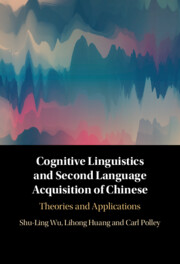Book contents
- Cognitive Linguistics and Second Language Acquisition of Chinese
- Cognitive Linguistics and Second Language Acquisition of Chinese
- Copyright page
- Contents
- Figures
- Tables
- Abbreviations
- Preface
- 1 Cognitive Linguistics and Second Language Acquisition
- 2 Construal in Language
- 3 Concepts and Categorization
- 4 Iconicity and Image Schemas
- 5 Metaphor and Metonymy
- 6 Polysemy
- 7 Embodied Cognition and Mental Simulation
- 8 Teaching Chinese Modal Verbs
- 9 The Future of Cognitive Linguistics in Chinese Studies
- References
- Index
7 - Embodied Cognition and Mental Simulation
Published online by Cambridge University Press: 01 February 2024
- Cognitive Linguistics and Second Language Acquisition of Chinese
- Cognitive Linguistics and Second Language Acquisition of Chinese
- Copyright page
- Contents
- Figures
- Tables
- Abbreviations
- Preface
- 1 Cognitive Linguistics and Second Language Acquisition
- 2 Construal in Language
- 3 Concepts and Categorization
- 4 Iconicity and Image Schemas
- 5 Metaphor and Metonymy
- 6 Polysemy
- 7 Embodied Cognition and Mental Simulation
- 8 Teaching Chinese Modal Verbs
- 9 The Future of Cognitive Linguistics in Chinese Studies
- References
- Index
Summary
Chapter 7 discusses the theory of simulation semantics, which claims that people spontaneously create mental simulations of the objects and actions expressed in language as part of the cognitive processes involved in language comprehension and production. When hearing a sentence like, “He kicked the ball, and it bounced off a tree into the pond,” our brain subconsciously uses the same neural assemblies that are involved in physically moving a leg to kick and watching an object move, while it also accesses experientially based memories that function as schematic representations of balls, trees, and ponds. CL studies further demonstrate how mental simulation is involved in comprehension of abstract and metaphorical language and how mental simulation can be shaped by syntactic structures, and preliminary research has been done to tease apart how mental simulation differs for L1 versus L2 comprehension. The chapter suggests ways in which new understandings of embodied cognition can inform the teaching and learning of Chinese in the classroom.
Keywords
- Type
- Chapter
- Information
- Cognitive Linguistics and Second Language Acquisition of ChineseTheories and Applications, pp. 148 - 177Publisher: Cambridge University PressPrint publication year: 2024



